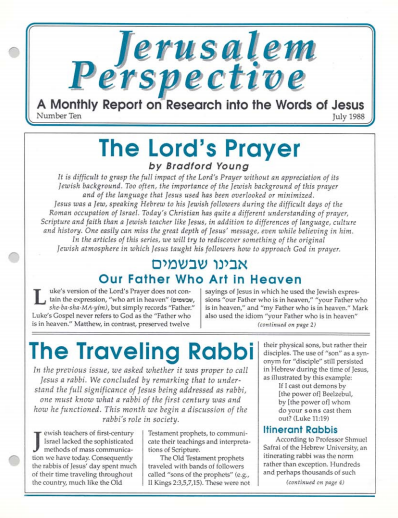Jewish teachers of first-century Israel lacked the sophisticated methods of mass communication we have today. Consequently, the sages of Jesus’ day spent much of their time traveling the land of Israel—much like the biblical prophets—to communicate their teachings and interpretations of Scripture.
The biblical prophet traveled with a band of followers called “sons of the prophets” (e.g., 2 Kgs. 2:3, 5, 7, 15). These were not the prophet’s physical sons, but rather the prophet’s disciples. The use of “son” as a synonym for “disciple” still persisted in Hebrew during the time of Jesus, as illustrated by this example from the Gospel of Luke:
If I cast out demons by [the power of] Beelzebul, by [the power of] whom do your sons [i.e., your disciples] cast them out? (Luke 11:19)
Premium Members and Friends of JP must be signed in to view this content.
If you are not a Premium Member or Friend, please consider registering. Prices start at $5/month if paid annually, with other options for monthly and quarterly and more: Sign Up For Premium

Because of such interdictions, almost all sages practiced a trade. Some were scribes; others, sandal makers, leather workers or bakers. Jesus himself, according to Mark 6:3, was a craftsman, and Acts 18:3 notes that Paul supported himself by making tents (or working leather, according to F. J. Foakes Jackson and Kirsopp Lake, The Acts of the Apostles [5 vols.; London: Macmillan, 1920-33], 4:223).





Comments 3
David, I am new to learning about the Hebrew Perspective, but I am a little confused in what you said here above, “Jesus had an inner circle of twelve disciples who received special training, but these were not his only disciples. He called others to follow him, including Levi, a tax collector.” Are you saying that Matthew/Levi was not part of the 12, given that Matt. 10:3 includes him in the list? Or, this is a way Jesus called disciples to himself?
Author
Shalom Bill!
You have made the equation Matthew = Levi; however, no disciple by the name of “Levi” is mentioned in the four listings of the Twelve’s names: Matt. 10:2-4; Mark 3:16-19; Luke 6:14-16; Acts 1:13.
And Shalom David!
Thanks for your timely response. I suppose this is another case of inference injected into the NT by other scholars that I have been subjected to for quite a while. I was always taught that Matthew and Levi were one in the same due to the similarity of the calling accounts for each and never thinking that they could be two separate folks with similar accounts, which if they are not to be equated is a possibility [please feel free to correct me if my thinking is wrong here]. Below is an excerpt from an older version of the ISBE under the topic of ‘Matthew’ which is why my thinking was as it was, “Before his call to the apostolic office, according to Mat_9:9, his name was Levi. The identity of Matthew and Levi is practically beyond all doubt, as is evident from the predicate in Mat_10:3; and from a comparison of Mar_2:14; Luk_5:27 with Mat_9:9.” I’m sure this is not the only source that shares this same opinion.
Thanks again for your input.
Peace to you in Jesus,
Bill Midgett
Rector, Christ the King Anglican Church, Winchester, TN